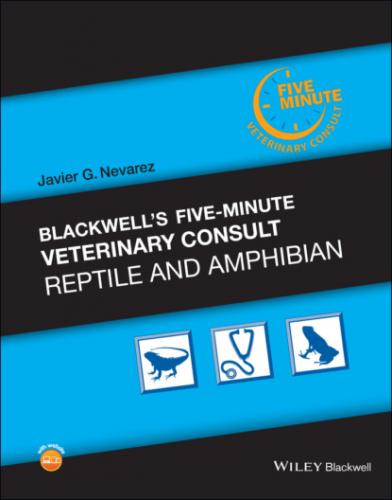ZOONOTIC POTENTIAL
Zoonotic potential will depend on the type of bacteria associated with the abscess.
Appropriate precautions must be taken when working with reptile abscesses to minimize exposure to zoonotic organisms.
SYNONYMS
Purulent dermatitis
Subcutaneous abscesses
Superficial pyoderma
ABBREVIATIONS
AST = aspartate aminotransferase
CPK = creatine phosphokinase
PCR = polymerase chain reaction
UVB = ultraviolet B
INTERNET RESOURCES
Kaplan M. Treating Abscesses in Reptiles. Melissa Kaplan’s Herp Care Collection. 1996, last updated January 1, 2014. www.anapsid.org/abscess.html
Negron V. 4 Diseases Your Pet Reptile Can Give You. May 1, 2015. www.petmd.com/reptile/care/diseases‐your‐pet‐reptile‐can‐give‐you
PetMD Editorial. Internal Abscesses in Reptiles. July 28, 2008. www.petmd.com/reptile/conditions/skin/c_rp_internal_abscesses
Suggested Reading
1 Huchzermeyer FW, Cooper JE. Fibriscess, not abscess, resulting from a localized inflammatory response to infection in reptiles and birds. Vet Record 2000; 147:515–517.
2 Mayer J, Pizzirani S, DeSena R. Bilateral exophtalmos in an adult iguana (Iguana iguana) caused by an orbital abscess. J Herp Med Surg 2010; 20:5–10.
3 Williams SR, Sims M, Roth‐Jonson L, Wickes B. Surgical removal of an abscess associated with Fusarium solani from a Kemp’s ridley sea turtle (Lepidochelys kempii). J Zoo Wildl Med 2012; 43:402–406.
Author Albert Martínez‐Silvestre, DVM, MSc, PhD, DECZM (Herpetology), EBVS European Veterinary Specialist in Herpetological Medicine and Surgery, Acred. AVEPA (Exotic Animals)
Adenovirus
DEFINITION/OVERVIEW
Adenoviruses have been found to infect all classes of bony vertebrates and most appear to have co‐evolved with their hosts.
Adenoviral infections in reptiles have ranged from clinically inapparent to enteritis, necrotizing hepatitis, esophagitis, splenitis, and encephalopathy.
ETIOLOGY/PATHOPHYSIOLOGY
Adenoviruses are double stranded non‐enveloped DNA viruses.
They fall in the family Adenoviridae, which is further classified into five currently accepted genera:Mastadenovirus isolated from mammalsAviadenovirus in birdsAtadenovirus isolated from squamatesSiadenovirus found in some chelonians, amphibians and birdsIchtadenovirus isolated from a sturgeon
A sixth genus, Testadenovirus, isolated from tortoises, has been proposed.
AdV infections have been identified in wild‐caught and captive lizards, snakes, chelonians, and crocodiles.
Disease is often a combination of other disease agents and/or stress and the viral infection.
SIGNALMENT/HISTORY
The listing below is of the species reported with an adenovirus isolate.Chelonians: Sulawesi tortoises, red‐footed tortoise, pancake tortoise, Eastern box turtle, ornate box turtle, red eared slider.
With molecular diagnostics, more affected species are expected to be identified.
There is no sex predilection.
Juvenile and/or stressed animals are more frequently reported with disease.
CLINICAL PRESENTATION
Non‐specific; often the animal is found dead.
Sulawesi tortoises had severe systemic disease and high mortality rate; however, these animals suffered multiple stressors.
Clinical signs included anorexia, lethargy, oral cavity ulcerations, nasal and ocular discharge, and diarrhea.
Subclinical disease has been reported in other tortoises.
RISK FACTORS
Husbandry
Adenoviruses are very stable in the environment and commonly spread through fecal–oral transmission.
Poor biosecurity can help disseminate the virus throughout a collection.
Others
Stressors such as capture, substandard housing, nutritional inadequacies or underlying disease play a role in the development of clinical infection.
Concurrent disease and/or immunosuppression increases the likelihood of severe systemic disease.
Sulawesi tortoises had concurrent amoebiasis, nematodiasis, and/or bacterial sepsis.
DIFFERENTIAL DIAGNOSIS
Intranuclear coccidiosis, mycoplasmosis, and tortoise herpesvirus 1.
DIAGNOSTICS
PCR may be diagnostic if the test is specific for the adenovirus commonly isolated from the reptile species.
Necropsy and histopathology: appropriate tissues need to be evaluated and, in some cases, additional tests such as TEM and/or PCR molecular diagnostics need to be performed.
PATHOLOGICAL FINDINGS
Sulawesi tortoises:
Gross lesions: hepatosplenomegaly, thick fibrinonecrotic membranes in the lumen of the large intestine, segmental darkening of the serosal surfaces of the small and large intestine, oronasal fìstulas, and tongue and oral mucosa ulceration.
Histology: heterophilic and lymphoplasmacytic infiltration of intestinal enteritis and hepatic necrosis. The inclusions are basophilic or amphophilic.
APPROPRIATE HEALTH CARE
N/A
